7133 Results

By the end of this section, you will be able to do the following:
Describe the properties of water that are critical to maintaining life
Explain why water is an excellent solvent
Provide examples of water’s cohesive and adhesive properties
Discuss the role of acids, bases, and buffers in homeostasis
- Subject:
- Applied Science
- Material Type:
- Module
- Date Added:
- 09/20/2018

By the end of this section, you will be able to do the following:
Identify the shared characteristics of the natural sciences
Summarize the steps of the scientific method
Compare inductive reasoning with deductive reasoning
Describe the goals of basic science and applied science
- Subject:
- Applied Science
- Material Type:
- Module
- Date Added:
- 09/20/2018

By the end of this section, you will be able to do the following:
Identify and describe the properties of life
Describe the levels of organization among living things
Recognize and interpret a phylogenetic tree
List examples of different subdisciplines in biology
- Material Type:
- Module
- Date Added:
- 09/20/2018

- Subject:
- Biology
- Material Type:
- Unit of Study
- Provider:
- Rice University
- Provider Set:
- OpenStax College
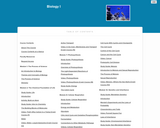
An introduction to biology intended for non-science majors. Focus areas include chemical foundations, cell structure and division, genetics, and evolution.
- Subject:
- Biology
- Natural Science
- Material Type:
- Full Course
- Textbook
- Provider:
- Lumen Learning
- Provider Set:
- Candela Courseware
- Author:
- David Fernandez
- Leslie Orzetti
- Paula Rodgers
- Date Added:
- 04/25/2019
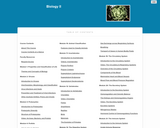
This template course was developed from generally available open educational resources (OER) in use at multiple institutions, drawing mostly from a primary work published by OpenStax College Concepts of Biology, but also including additional open works from various sources as noted in attributions on each page of materials.
- Subject:
- Biology
- Natural Science
- Material Type:
- Full Course
- Textbook
- Provider:
- Lumen Learning
- Provider Set:
- Candela Courseware
- Date Added:
- 04/25/2019

This material is labwork meant to be used in conjunction with the Candela "Biology II" course.
- Subject:
- Biology
- Natural Science
- Material Type:
- Activity/Lab
- Provider:
- Lumen Learning
- Provider Set:
- Candela Courseware
- Author:
- Lynette Hauser
- Stacy Forgey
- Date Added:
- 04/25/2019

Biology, The Cell is an unit of study no. 3 of the Biology full course. It is grounded on studying cells, including cell structure, structure and function of plasma membranes, metabolism, cellular respiration, photosynthesis, cell communication, and cell reproduction.
- Subject:
- Biology
- Histology
- Natural Science
- Material Type:
- Diagram/Illustration
- Module
- Unit of Study
- Date Added:
- 03/26/2019
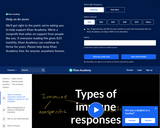
This 8-minute video lesson presents an overview of types of immune responses. It looks at the difference between innate and adaptive immunity and the differences between humoral adaptive immunity and cell-mediated adaptive immunity. [Biology playlist: Lesson 52 of 71].
- Subject:
- Biology
- Natural Science
- Material Type:
- Lecture
- Provider:
- Khan Academy
- Provider Set:
- Khan Academy
- Author:
- Salman Khan
- Date Added:
- 11/12/2019
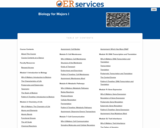
Module 1: Introduction to Biology
The Characteristics of Life
Prokaryotes and Eukaryotes
Taxonomy
The Study of Biology
Module 2: Chemistry of Life
Atoms and Elements
Atomic Bonds
Functional Groups
The pH Scale
Chemical Reactions
Thermodynamics
Assignment: Biological Astronaut
Module 3: Important Biological Macromolecules
Proteins
Lipids
Carbohydrates
Nucleic Acids
Comparing Biological Macromolecules
Assignment: Nutritionist for a Day
Module 4: Cellular Structure
Microscopy
Organelles
The Cytoskeleton
The Cell Surface
Assignment: Cell Builder
Module 5: Cell Membranes
Structure of the Membrane
Kinds of Transport
Endocytosis and Exocytosis
Assignment: Membranes Alive!
Module 6: Metabolic Pathways
Redox Reactions
Photosynthesis
Cellular Respiration
Fermentation
Assignment: Observing Energy Transactions
Module 7: Cell Communication
Signaling Molecules and Cellular Receptors
Propagation of the Signal
Response to the Signal
Signaling in Single-Celled Organisms
Module 8: Cell Division
Chromosomes and DNA Packaging
The Cell Cycle
Cell Cycle Checkpoints
Meiosis
Genetic Diversity
Errors in Chromosome Number
Assignment: Mitosis and Meiosis Internet Quests
Module 9: DNA Structure and Replication
Storing Genetic Information
DNA Base Pairs and Replication
DNA Mutations
Assignment: Which Has More DNA?
Module 10: DNA Transcription and Translation
Transcription
Translation
Prokaryotic Transcription and Translation
The Central Dogma
Module 11: Gene Expression
Regulation of Gene Expression
Prokaryotic Gene Regulation
Eukaryotic Gene Regulation
Assignment: How Mutations Work
Module 12: Trait Inheritance
The Father of Genetics
Beyond Dominance and Recessiveness
Heredity and Disease
Genetics and the Environment
Assignment: Dragon Genetics
Module 13: Theory of Evolution
Charles Darwin
Evidence for Evolution
Mutations and Evolution
Phylogenetic Trees
Module 14: Modern Biology
Key Technologies
Biotechnology Applications
Risks and Benefits of Genomic Science
Assignment: When Jabberjays Attack!
- Subject:
- Biology
- Natural Science
- Material Type:
- Full Course
- Author:
- Lumen Learning
- Date Added:
- 11/30/2020
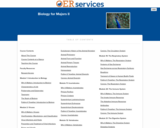
Module 1: Introduction to Biology
Characteristics of Life
Prokaryotes and Eukaryotes
Taxonomy
The Study of Biology
Module 2: Viruses
Viral Evolution, Morphology, and Classification
Virus Infections and Hosts
Prevention and Treatment of Viral Infections
Prions and Viroids
Module 3: History of Life
Evolution
Speciation
The Evolution of Populations
Phylogenies and the History of Life
Module 4: Prokaryotes
Prokaryotic Diversity
The Structure of Prokaryotes
Prokaryotic Metabolism
Bacterial Diseases in Humans
Beneficial Prokaryotes
Module 5: Protists
Characteristics of Protists
Groups of Protists
Ecology of Protists
Module 6: Fungi
Characteristics of Fungi
Classifications of Fungi
Ecology of Fungi
Fungal Parasites and Pathogens
Module 7: Plant Diversity
Seedless Plants
Seed Plants
Module 8: Plant Structure and Function
Plant Structures
Transport of Water and Solutes in Plants
Plant Sensory Systems and Responses
Plant Growth
Plant Nutrition
Module 9: Plant Reproduction
Reproductive Development and Structure
Asexual Reproduction in Plants
Sexual Reproduction in Plants
Module 10: Animal Diversity
Evolutionary History of the Animal Kingdom
Animal Phylogeny
Animal Form and Function
Animal Primary Tissues
Animal Reproduction
Homeostasis
Module 11: Invertebrates
Phylum Porifera
Phylum Cnidaria
Superphylum Lophotrochozoa
Superphylum Ecdysozoa
Superphylum Deuterostomia
Module 12: Vertebrates
Chordates
Fishes
Amphibians
Amniotes
Reptiles
Birds
Mammals
Module 13: Overview of Body Systems
Integration of Systems
Control Systems
Cell Maintenance Systems
Support Systems
Module 14: The Nervous System
Components of the Nervous System
Neuron Communication
The Central Nervous System
The Peripheral Nervous System
Nervous System Disorders
Module 15: The Endocrine System
Types of Hormones
How Hormones Work
Regulation of Body Processes
Endocrine Glands
Module 16: The Reproductive System
Reproduction Methods
Human Reproductive Anatomy
Hormonal Control of Human Reproduction
Fertilization
Early Embryonic Development
Human Pregnancy and Birth
Module 17: Sensory Systems
The Senses
Somatosensation
Taste and Smell
Hearing and Vestibular Sensation
Vision
Module 18: The Circulatory System
The Circulatory System
Structure and Function of Blood
The Mammalian Heart
Blood Flow and Blood Pressure Regulation
Module 19: The Respiratory System
Systems of Gas Exchange
Gas Exchange across Respiratory Surfaces
Breathing
Transport of Gases in Human Bodily Fluids
Module 20: The Immune System
The Innate Immune Response
The Adaptive Immune Response
Antibodies
Module 21: The Digestive System
Digestive Systems
Nutrition and Energy Production
Digestive System Processes and Regulation
Module 22: The Excretory System
Osmoregulation and Osmotic Balance
Kidneys and Osmoregulatory Organs
Excretion Systems
Module 23: The Musculoskeletal System
Skeletal Systems
Bones
Joints and Skeletal Movement
Muscle Contraction and Locomotion
Module 24: The Integumentary System
Structure and Function of Skin
Accessory Structures of the Skin
Functions of the Integumentary System
Diseases, Disorders, and Injuries of the Integumentary System
Module 25: Ecology of Living Things
The Scope of Ecology
Biotic and Abiotic Factors
Biomes
Population Ecology
Community Ecology
Module 26: Ecology and the Environment
Energy in the Environment
Biogeochemical Cycles
Climate Change
Conservation Biology and Biodiversity
- Subject:
- Biology
- Natural Science
- Material Type:
- Full Course
- Author:
- Lumen Learning
- Date Added:
- 11/30/2020
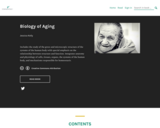
Includes the study of the gross and microscopic structure of the systems of the human body with special emphasis on the relationship between structure and function. Integrates anatomy and physiology of cells, tissues, organs, the systems of the human body, and mechanisms responsible for homeostasis.
Also available here:https://courses.lumenlearning.com/atd-herkimer-biologyofaging/
Table of Contents:
I. Chapter 1: Introduction to Human Aging
II. Chapter 2: Theories of Aging
III. Chapter 3: Cellular Aging
IV. Chapter 4: The Integumentary System
V. Chapter 5: Bone Tissue and The Skeletal System
VI. Chapter 6: The Skeletal Muscle System
VII. Chapter 7: The Nervous System
VIII. Chapter 8: The Special Senses
IX. Chapter 9: The Circulatory System
X. Chapter 10: The Immune System
XI. Chapter 11: The Respiratory System
XII. Chapter 12: The Digestive System
XIII. Chapter 13: The Urinary System
XIV. Chapter 14: The Reproductive System
XV. Chapter 15: The Endocrine System
XVI. Course Information
XVII. Term Research Project
- Subject:
- Biology
- Natural Science
- Material Type:
- Textbook
- Author:
- Lumen Learning
- Jessica Kelly
- Date Added:
- 04/12/2021

"This course covers the principles of materials science and cell biology underlying the design of medical implants, artificial organs, and matrices for tissue engineering. Methods for biomaterials surface characterization and analysis of protein adsorption on biomaterials. Molecular and cellular interactions with biomaterials are analyzed in terms of unit cell processes, such as matrix synthesis, degradation, and contraction. Mechanisms underlying wound healing and tissue remodeling following implantation in various organs. Tissue and organ regeneration. Design of implants and prostheses based on control of biomaterials-tissue interactions. Comparative analysis of intact, biodegradable, and bioreplaceable implants by reference to case studies. Criteria for restoration of physiological function for tissues and organs."
- Subject:
- Biology
- Natural Science
- Material Type:
- Full Course
- Provider:
- M.I.T.
- Provider Set:
- M.I.T. OpenCourseWare
- Author:
- Spector, Myron
- Yannas, Ioannis
- Date Added:
- 01/01/2009
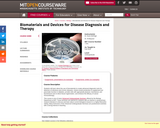
Students will learn about the use of biomaterials to create advanced diagnostic tools for detection of infectious and chronic diseases, restore insulin production to supplement lost pancreatic function in diabetes, provide cells with appropriate physical, mechanical, and biochemical cues to direct tissue regeneration, and enhance the efficacy of cancer immunotherapy.
This course is one of many Advanced Undergraduate Seminars offered by the Biology Department at MIT. These seminars are tailored for students with an interest in using primary research literature to discuss and learn about current biological research in a highly interactive setting. Many instructors of the Advanced Undergraduate Seminars are postdoctoral scientists with a strong interest in teaching.
- Subject:
- Applied Science
- Health, Medicine and Nursing
- Material Type:
- Full Course
- Provider:
- M.I.T.
- Provider Set:
- M.I.T. OpenCourseWare
- Author:
- Ali Beyzavi
- Kevin McHugh
- Date Added:
- 01/01/2018

This is a custom textbook catered to the needs of kinesiology students enrolled in a first-year biomechanics course. It has been modified from OpenStax College Physics and Anatomy and Physiology.
I. Chapter 1: Prerequisite Skills for Biomechanics
II. Chapter 2: Anatomy Basics
III. Chapter 3: Linear Kinematics in One-dimension
IV. Chapter 4: Linear Kinematics in Two-dimensions
V. Chapter 5: Angular Kinematics
VI. Chapter 6: Linear Kinetics
VII. Chapter 7: Work, Power, and Energy
VIII. Chapter 8: Angular Kinetics
IX. Chapter 9: Mechanics of Human Tissues
X. Chapter 10: Mechanism of Injury
- Subject:
- Applied Science
- Health, Medicine and Nursing
- Material Type:
- Textbook
- Provider:
- BCcampus
- Date Added:
- 04/13/2021
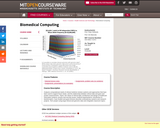
Analyzes computational needs of clinical medicine reviews systems and approaches that have been used to support those needs, and the relationship between clinical data and gene and protein measurements. Topics: the nature of clinical data; architecture and design of healthcare information systems; privacy and security issues; medical expertsystems; introduction to bioinformatics. Case studies and guest lectures describe contemporary systems and research projects. Term project using large clinical and genomic data sets integrates classroom topics.
- Subject:
- Applied Science
- Health, Medicine and Nursing
- Material Type:
- Full Course
- Provider:
- M.I.T.
- Provider Set:
- M.I.T. OpenCourseWare
- Author:
- Alterovitz, Gil
- Szolovits, Peter
- Date Added:
- 01/01/2010
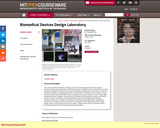
This course provides intensive coverage of the theory and practice of electromechanical instrument design with application to biomedical devices. Students will work with MGH doctors to develop new medical products from concept to prototype development and testing. Lectures will present techniques for designing electronic circuits as part of complete sensor systems. Topics covered include: basic electronics circuits, principles of accuracy, op amp circuits, analog signal conditioning, power supplies, microprocessors, wireless communications, sensors, and sensor interface circuits. Labs will cover practical printed circuit board (PCB) design including component selection, PCB layout, assembly, and planning and budgeting for large projects. Problem sets and labs in the first six weeks are in support of the project. Major team-based design, build, and test project in the last six weeks. Student teams will be composed of both electrical engineering and mechanical engineering students.
- Subject:
- Applied Science
- Engineering
- Material Type:
- Full Course
- Provider:
- M.I.T.
- Provider Set:
- M.I.T. OpenCourseWare
- Author:
- Ma, Hongshen
- Date Added:
- 01/01/2007


